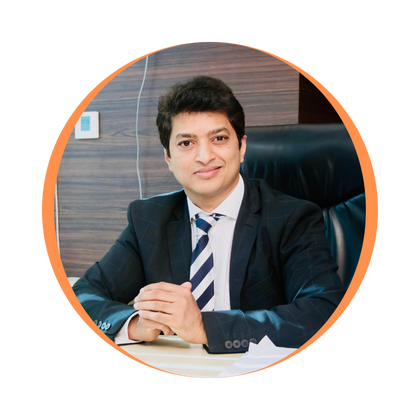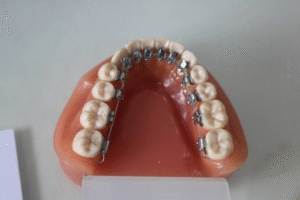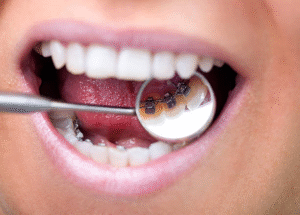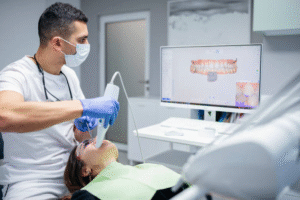Lingual Braces
Lingual Braces in Mumbai
Some aspects of our appearance are beyond our control—crooked teeth, bite issues, or jaw alignment problems often develop naturally over time. But the impact they have on our lives—how freely we smile, speak, or laugh—can be deeply personal. Fortunately, modern orthodontics offers solutions that are as subtle as they are effective.
One such innovation is lingual braces, placed on the inner side of the teeth, making them virtually invisible from the outside. Globally, the demand for discreet orthodontic options has surged. In India, this trend is quickly catching on, especially among working professionals, students, and public-facing individuals.
At the forefront of this movement is Dr. Pravin Shetty, Founder of B.Braced Orthodontic Center in Mumbai. He shares, “Lingual braces give patients the freedom to correct their smiles without revealing they’re undergoing treatment. This approach suits those who are appearance-conscious or have professional roles that demand public interaction. The results are as accurate as traditional braces—just more discreet.”
Dr. Pravin Shetty has played a pivotal role in advancing lingual orthodontics in India and abroad. With more than 2 decades of expertise, he‘s a sought-after expert for people seeking Lingual Braces in Mumbai.
Looking for an orthodontic solution that doesn’t show? Here’s why this doctor’s approach stands out.
Why Get Lingual Braces with Dr. Pravin Shetty?
When it comes to lingual braces, experience and precision matter. This technique requires specialized expertise, and Dr. Pravin Shetty’s reputation is built on both.
Here’s what makes his approach uniquely effective:
Inventor of Advanced Systems:
Dr. Shetty developed the Lingualmatrix, a custom CAD/CAM-based 3D bracket system used worldwide for tailored lingual treatments.
Global Educator:
He has lectured in Seoul, Germany, Portugal, Australia, and more, training other orthodontists on lingual techniques.
Digital Orthodontics Pioneer:
Every case is planned using 3D scanning and software to ensure precision and predictability.
ISO-Certified Setup:
His clinic in Khar offers a tech-forward, hygienic, and ISO 2002:2008 certified facility for orthodontic care.

Patient-Centric Care:
His team focuses on detailed evaluations, face-focused smile planning, and regular follow-ups to keep patients comfortable and informed.
“Every smile is unique. Our goal is to design treatments that enhance not just the teeth, but the entire facial profile,” shares Dr. Pravin Shetty, a respected innovator in digital orthodontics.”
Curious about affordability? Here’s what influences the cost.
Cost of Lingual Braces in Mumbai: What to Expect
On average, lingual braces cost in Mumbai ranges from ₹1,50,000 to ₹3,50,000. Cost is determined by several factors:
Severity of Misalignment: More complex cases take longer and require advanced customization.
Type of Lingual Brackets Used: Standard systems cost less than custom-engineered ones like Lingualmatrix.
Duration of Treatment: Longer treatments mean more follow-up visits and adjustments.
Lab and Material Charges: Precision brackets and wires are specially designed for each patient.
Orthodontist’s Expertise: Specialists with global recognition and innovation credentials often charge higher for the value and accuracy they bring.
“Lingual braces are a premium orthodontic solution. Their hidden placement and customization contribute to a slightly higher price point than traditional braces. While the initial investment may seem higher, lingual braces offer a level of privacy and precision unmatched by other options,” notes Dr. Pravin Shetty, an acclaimed expert in lingual technology.
Wondering how they actually straighten your teeth without anyone knowing?
The Science Behind Lingual Braces
Lingual braces function like traditional braces but with a critical twist—they’re placed on the back surfaces of your teeth, hidden from view.
Here’s how they achieve results:
Bracket Placement: Custom-designed brackets are bonded to the inside of the teeth.
Archwire Activation: Specially curved wires apply gentle, continuous pressure to guide teeth into alignment.
Precision Engineering: CAD/CAM tools are used to design each component to match the contours of your teeth.
Regular Adjustments: Like conventional braces, these are periodically tightened to progress treatment.

“The biomechanics of lingual braces are similar to traditional ones, but they require a higher level of planning and execution due to their placement,” explains Dr. Pravin Shetty, a skilled lingual orthodontic specialist.
Let’s take a look at the styles available for different needs.
Types of Lingual Braces Available at Our Clinic
At Dr. Pravin Shetty’s clinic, multiple lingual systems are available to suit varying needs and budgets.
Standard Lingual Braces
Pre-formed brackets suited for general alignment cases. More affordable but less customizable.
Customized CAD/CAM Lingual Braces
These include Lingualmatrix—fully individualized bracket systems designed using 3D scans for precise tooth movement.
Self-Ligating Lingual Braces
These use advanced clip mechanisms instead of elastics, reducing friction and possibly speeding up treatment.
Hybrid Systems
Some patients benefit from a combination of lingual braces in the upper jaw and traditional or ceramic braces in the lower—offering cost flexibility without compromising on aesthetics.

“We recommend systems based on both functional needs and lifestyle preferences, ensuring a smooth and satisfying experience,”
adds Dr. Pravin Shetty , a pioneering Orthodontist in Mumbai.
Who Can Benefit from Lingual Braces?
Lingual braces are ideal for many patients—but not everyone is a candidate. Here’s a quick guide to help you understand who might benefit most:
You’re likely a candidate if you:
May not be ideal if:
- Are concerned about visible braces due to work, media, or public-facing roles
- Want effective correction for mild to moderate malocclusion
- Have healthy teeth and gums, with good oral hygiene habits
- Are motivated and willing to adapt to the initial adjustment phase
- You have very small teeth (limiting bracket placement space)
- You need major bite correction with jaw movement
- You’re struggling with significant speech or tongue sensitivity

“It’s not just about what looks good—it’s about what works best. That’s why we conduct in-depth evaluations before recommending any system,” explains Dr. Pravin Shetty, a strategic clinician in advanced orthodontics.
From your first consultation to your final smile—here’s how it all unfolds.
Step-by-Step Lingual Braces Treatment Journey
Patients often wonder what happens between choosing lingual braces and completing treatment. Here’s a simplified breakdown:
Clinical Consultation & 3D Scanning
- Full dental exam with high-resolution scans
- Assessment of facial aesthetics and bite alignment
- Customized smile design simulation
Design & Fabrication
- Brackets and archwires designed using CAD/CAM tools
- Each bracket tailored to fit the back of your teeth precisely
Bonding Appointment
- Brackets placed carefully on the lingual surfaces
- Archwires secured and initial forces applied

Follow-Up Visits
- Adjustments every 6–8 weeks to monitor progress
- Patient education on speech, oral hygiene, and care.
Completion & Retention
- Braces removed once alignment is achieved
- Retainers given to maintain results over time
“Our treatment journey is collaborative—each visit is a checkpoint, and each milestone is a step closer to a confident smile,” emphasizes Dr. Pravin Shetty.
Let’s tackle some common questions patients often have.
Frequently Asked Questions
Yes, they are just as effective as traditional braces in correcting most alignment issues. However, due to their placement, treatment planning must be meticulous and guided by a trained specialist.
The average treatment time ranges from 18 to 30 months, depending on the case. Simpler alignments may take less time, while complex bite issues could extend the duration.
It takes a few weeks to adjust. Start with soft foods like rice, yogurt, and cooked vegetables. Avoid sticky or hard foods that could dislodge brackets. Over time, most patients return to a normal diet with minor modifications.
They can cause initial tongue irritation and slight speech lisping. However, discomfort usually subsides within a few weeks. The force applied is gentle and similar to traditional braces.
Yes, but it requires diligence. Use an interdental brush, tongue scrapers, and a water flosser. Regular hygiene visits are recommended to keep the back of the teeth plaque-free.
Disclaimer: The information shared in this content is for educational purposes only and not for promotional use.
